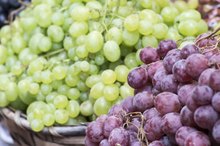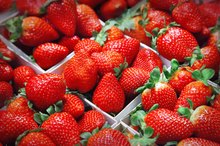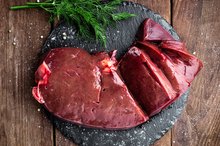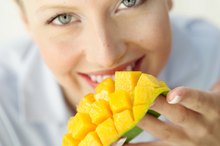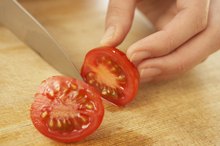3 Types of Fruits Best for People With Gout
Gout is called a rheumatic, or inflammatory, disease because its symptoms develop when your blood level of uric acid is high, causing small, needle-like uric acid crystals to form in your joints and provoke inflammation. Its symptoms may come and go, but during a flare-up you might develop hot, swollen and painful joints. When you digest foods containing purines, your body produces uric acid as a waste product, so a healthy gout diet includes careful attention to purine content, particularly choosing the best fruits to help prevent or minimize these symptoms.
Low-Purine Choices
High-blood levels of uric acid can result from overproduction of uric acid, its slow excretion by your kidneys, or a combination of both problems. The amount of uric acid produced during digestion of a food is determined by how much purine it contains, so high-purine foods are the most important foods to avoid with gout. A food is generally considered low in purines if your body produces 100 milligrams or less of uric acid for each 100 grams of food you consume. Other good choices that produce less than 50 milligrams of uric acid per 100 grams include oranges, dates and cantaloupe.
- High-blood levels of uric acid can result from overproduction of uric acid, its slow excretion by your kidneys, or a combination of both problems.
- The amount of uric acid produced during digestion of a food is determined by how much purine it contains, so high-purine foods are the most important foods to avoid with gout.
High-Fiber Fruits
What Fruits to Avoid for Diabetic & Uric Acid Patients
Learn More
To support general health, the Dietary Guidelines for Americans suggest that men and women take in 25 and 38 grams of dietary fiber each day, respectively 6. If you have gout, eating lots of fiber can be especially helpful, according to the University of Maryland Medical Center 3. Although most fruits tend to be high-fiber foods, it's important to choose those that are also low in purines to help keep your uric acid levels low. Good examples include bananas, which are low in purines and also high in fiber, with about 2 grams in 1 small banana. Pears and plums are also high in fiber, especially if you consume the peel — 1/2 of a large pear provides about 3 grams of fiber and 2 medium plums contain 2.4 grams of fiber, with both fruits also low in purines.
- To support general health, the Dietary Guidelines for Americans.
- Good examples include bananas, which are low in purines and also high in fiber, with about 2 grams in 1 small banana.
Fruit Phytonutrients
Most fruits contain natural compounds belonging to a group called flavonoids. These biologically active compounds are antioxidants that can help your body rid itself of free radicals, which are unstable compounds that form during digestion or when you're exposed to toxins. Over time, free radicals can accumulate and cause inflammation, so consume flavonoid-rich fruits regularly to help lessen problems arising from gout. Fruits high in these natural anti-inflammatory compounds but low in purines include raspberries and other berries, plums and grapes They contain several types of these phytonutrients, called anthocyanins, flavonols and proanthocyanidins.
- Most fruits contain natural compounds belonging to a group called flavonoids.
- These biologically active compounds are antioxidants that can help your body rid itself of free radicals, which are unstable compounds that form during digestion or when you're exposed to toxins.
Choose High Purine Foods With Care
Strawberries for Gout
Learn More
Although most foods high in purine are meat-based or contain yeast, some dried fruits might be rich in purines. For example, consuming 100 grams of raisins can produce about 100 milligrams of uric acid, a moderately high amount. Choose these types of dried fruits only occasionally and, when you do, consume them in small amounts. If you have gout, talk to your doctor or to a registered dietitian to decide on the best fruit choices for you.
- Although most foods high in purine are meat-based or contain yeast, some dried fruits might be rich in purines.
- Choose these types of dried fruits only occasionally and, when you do, consume them in small amounts.
Related Articles
References
- Centers for Disease Control and Prevention: Gout
- Acumedico: Various Food Types and Their Purine Content
- University of Maryland Medical Center: Gout
- Linus Pauling Institute: Flavonoids
- Linus Pauling Institute: Anthocyanin, Flavanol and Proanthocyanidin Content of Selected Foods
- U.S. Department of Agriculture: 2010 Dietary Guidelines for Americans
- The Merck Manual for Health Care Professionals. "Gout." Accessed March 25, 2016. http://www.merckmanuals.com/professional/musculoskeletal_and_connective_tissue_disorders/crystal-induced_arthritides/gout.html
- National Institute of Arthritis and Musculoskeletal and Skin Diseases. "Questions and Answers About Gout." Accessed March 25, 2016. http://www.niams.nih.gov/Health_Info/Gout
- The Merck Manual for Health Care Professionals. "Gout." Accessed March 25, 2016.
- National Institute of Arthritis and Musculoskeletal and Skin Diseases. "Questions and Answers About Gout." Accessed March 25, 2016.
Writer Bio
Joanne Marie began writing professionally in 1981. Her work has appeared in health, medical and scientific publications such as Endocrinology and Journal of Cell Biology. She has also published in hobbyist offerings such as The Hobstarand The Bagpiper. Marie is a certified master gardener and has a Ph.D. in anatomy from Temple University School of Medicine.
